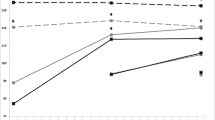Summary
Investigations on the age-composition of the carabid beetle Calathus melanocephalus are discussed in a number of papers. The overall aim of this study is to estimate the significance of the variability in the age-composition in time and space of field populations of this species. This variability is thought to contribute to some degree to the stabilization of the fluctuations in animal numbers from year to year by which, for this species, the “chance to survive” in some area will be increased.
In an earlier paper the occurrence of this variability was demonstrated by comparing three populations of this species living in three different localities at Schiermonnikoog, and by comparing one population in three succeeding years. This paper tries to develop a general strategy for investigating the degree of variability in the age-composition of field populations of carabid beetles.
Two methods of investigation are discussed, i.e.:
-
1.
By means of experiments with separated individuals of the overwintered and young generation inside enclosures it is shown that the females of the two generations can be distinguished by differences in the developmental stages of the ovaries, especially indicated by the distinctness of the corpora lutea. As for the males, the colour of the aedeagus and of the border of the genital plate is used for this purpose.
Also from these experiments the length of the period within the breeding season during which the two generations can be distinguished is estimated. The results of these experiments can be used with sampled field populations to estimate the frequency distribution of the different developmental stages of the reproductive organs and their changes in time.
-
2.
From the release of individually marked specimens of both generations inside enclosures and by their recapture and further release it is demonstrated that differences occur between the curves of cumulative recaptures for the two generations. In this way it has been shown also that the main period of reproductive activities of the two generations occurs in different parts of the breeding season.
The paper also discusses to what extent the relative contribution of each generation to the sizes of populations can be estimated by comparing the curves representing the cumulative captures from field populations.
Similar content being viewed by others
References
Boer, P.J. den: Zoo-ecological research at the Biological Station, Wijster. Paper read at the Summer Meeting of the British Ecological Society in the Netherlands in 1965. Belmontia 13, II: Ecology. Can be obtained from the Biological Station, Wijster, 1968a.
Boer, P.J. den: Spreading of risk and stabilization of animal numbers. Acta biotheor. (Leiden) 18, 165–194 (1968b).
Boer, P.J. den: Stabilization of animal numbers and the heterogeneity of the environments. The problem of the persistence of sparse populations. Proc. Adv. Study Inst. Dynamics Numbers Popul. (Oosterbeek, 1970), P.J. den Boer and G.R. Gradwell, Eds.) Wageningen: Pudoc 1971.
Bouix, G.: Phénomènes de dégénérescence dans les organes sexuels des carabes (Col., Car.). Bull. Soc. Zool., France 87, 139–150 (1962).
Danilevskii, A.S.: Photoperiodism and seasonal development of insects. London: Oliver & Boyd 1965.
Davey, K.G.: Reproduction in the insects. London: Oliver & Boyd 1965.
Dawson, Nancy: A comparative study of the ecology of eight species of fenland Carabidae (Coleoptera). J. anim. Ecol. 34, 299–314 (1965).
Demandt, C.: Der Geschlechtsapparat von Dytiscus marginalis L. Zt. wiss. Zool. 103, 171–299 (1912).
Dijk, Th.S. van: The significance of the diversity in agecomposition of Calathus melanocephalus L. (Col., Car.) in space and time at Schiermonnikoog. Oecologia (Berl.) 10, 1–26 (1972).
Engelmann, F.: The physiology of insect reproduction. Oxford: Pergamon Press 1970.
Gilbert, O.: The natural histories of four species of Calathus (Col. Car) living on sand-dunes in Anglesey, North Wales. Oikos 7, 22–47 (1956).
Joly, P.: La fonction ovarienne et son contrôle humural chez les Dytiscides. Arch. Zool. exp. 84, 49–164 (1945).
Joly, P.: Fonctionnement ovarien des carabes. C.R. Soc. Biol. (Paris) 144II, 1217–1220 (1950).
Kern, P.: Über die Fortpflanzung und Eibildung bei einigen Caraben. Zool. Anz. 40, 345–351 (1912).
Kiritani, K.: The change in reproductive system of the southern green stink bug, Nezara viridula and its application to forecasting of the seasonal history. Jap. J. Appl. Entom. and Zool. 7, 327–337 (1963).
Krehan, I.: Die Steuerung von Jahresrhythmik und Diapause bei Larval- und Imagoüberwinterern der Gattung Pterostichus (Col. Car.). Oecologia (Berl.) 6, 58–105 (1970).
Milliron, H.E.: A succesful method for artificially hibernating Megabombus fervidus fervidus (F.) and notes on a related species (Hymenoptera: Apidae, Bombinae). Can. Ent. 99, 1321–1332 (1967).
Murdoch, W.W.: Population stability and life history phenomena. Amer. Naturalist 100, 5–11 (1966).
Reddingius, J., Boer, P.J. den: Simulation experiments illustrating stabilization of animal numbers by spreading of risk. Oecologia (Berl.) 5, 240–284 (1970).
Thiele, H.U.: Die Steuerung der Jahresrhythmik von Carabiden durch exogene und endogene Faktoren. Zool. Jb. Abt. System Ökol. u. Geogr. 98, 341–371 (1971).
Vlijm, L., Dijk, Th.S. van: Ecological studies on carabid beetles. II. General pattern of population structure in Calathus melanocephalus (Linn.) at Schiermonnikoog. Z. Morph. Ökol. Tiere 58, 396–404 (1967).
Vlijm, L., Dijk, Th.S. van, Wijmans, S.Y.: Ecological studies on carabid beetles III. Wintermortality in adult Calathus melanocephalus (Linn.). Egg production and locomotory activity of the population which has hibernated. Oecologia (Berl.) 1, 304–314 (1968).
Wigglesworth, V.B.: The principles of insect physiology, 5th ed. London: Methuen 1955.
Wilde, J. de: Reproduction. In: The physiology of insects, M. Rockstein, Ed., vol. I, p. 9–58. London: Academic Press 1964.
Author information
Authors and Affiliations
Additional information
Communication No. 162 of the Biological Station, Wijster.
Rights and permissions
About this article
Cite this article
van Dijk, T.S. The age-composition of populations of Calathus melanocephalus L. analysed by studying marked individuals kept within fenced sites. Oecologia 12, 213–240 (1973). https://doi.org/10.1007/BF00347564
Received:
Issue Date:
DOI: https://doi.org/10.1007/BF00347564




